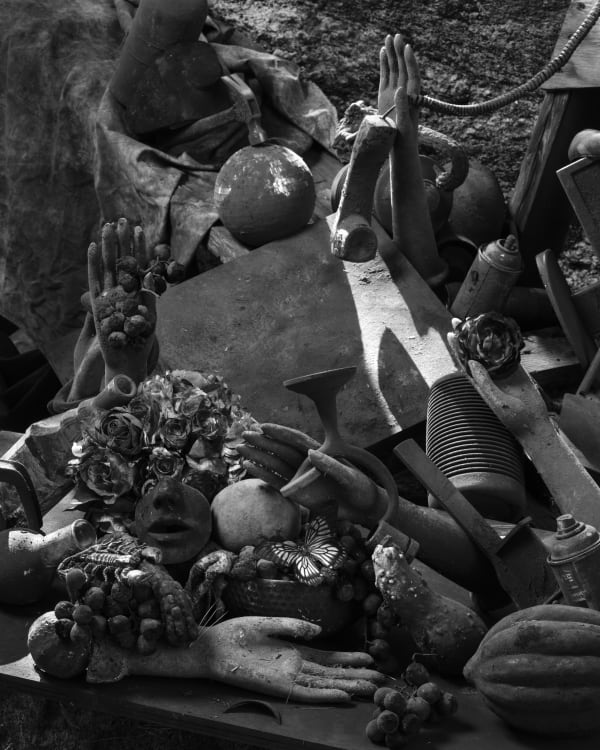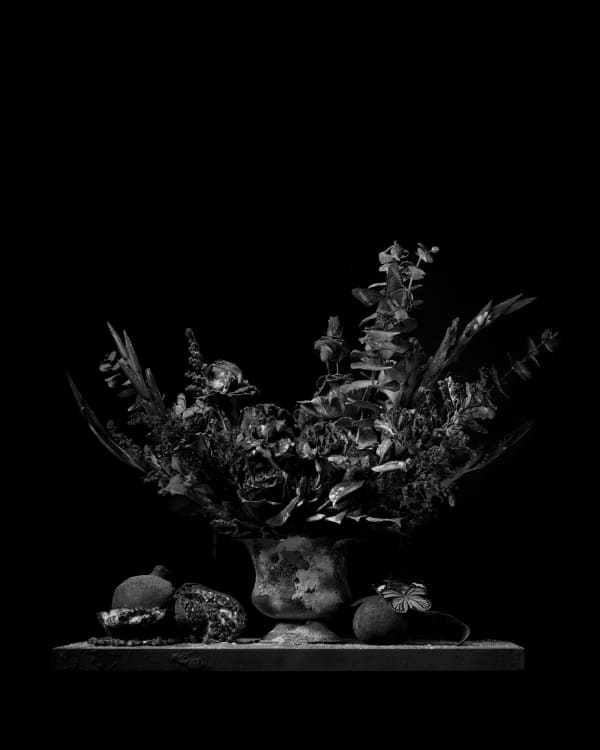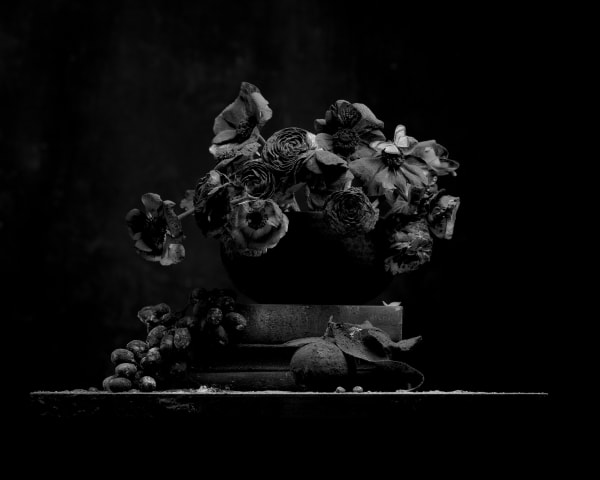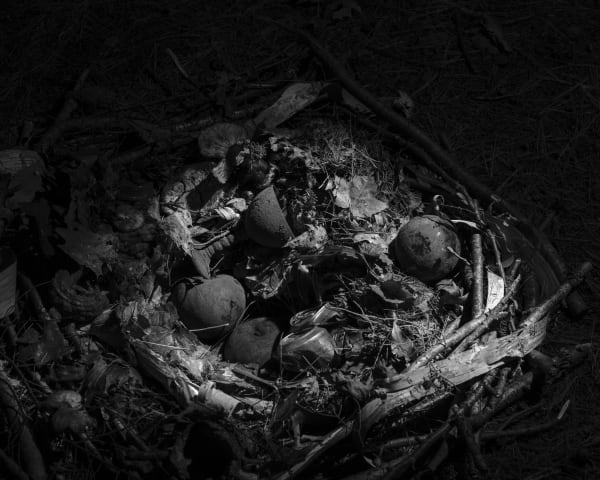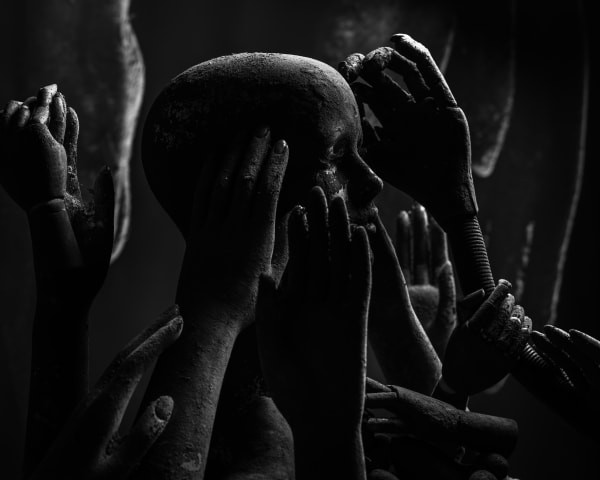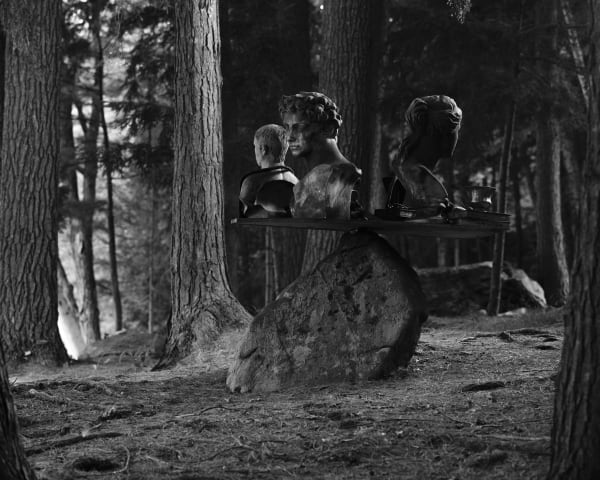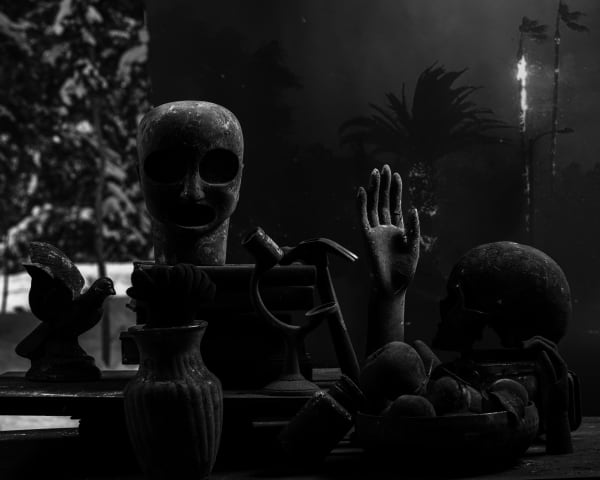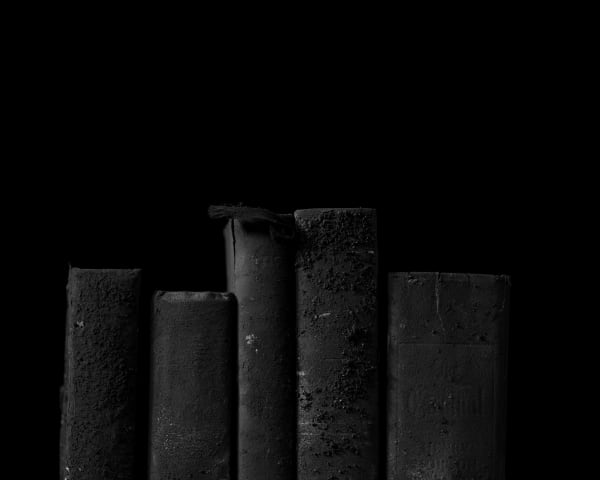-
Core Exhibition of the Contact Festival 2022What happens to the artifacts of our civilized world when they no longer serve a purpose? Are they burned to the ground or left to collect dust?
Multidisciplinary artist Ryan Van Der Hout reimagines traditional still life vanitas in this photographic and installation-based solo exhibition that considers the human fascination with mortality. His series of black-and-white photographs explores the personal and universal transformations and rebirth that emerged amid the current pandemic, along with their accompanying anxiety and grief.
Van Der Hout’s compositions take on the illusion of artifacts documented within a world of decay. In them, tables are adorned with canonical symbols such as skulls and butterflies, placed among sex toys, Shabbos candles, and other personal items. The artist covers these meticulously arranged tableaux with dust and ash, to don the appearance of years of neglect. Closer inspection reveals that the still lifes’ subjects, while alluding to a post-apocalyptic present, actually belong to a world outside of time.
In We Are What We Pretend To Be (2021), contemporary items are positioned alongside a recently blown out candle, in the style of a Dutch vanitas painting of the Baroque period. Removing these symbols from their historical contexts collapses time upon itself, engendering simultaneous, parallel visions of decay. In the forest clearing depicted in Stress Test (2021), three sculpted busts sit tenuously atop a board balanced upon a large stone, looking outwards in all directions. The delicate arrangement implies human presence, while highlighting its absence.
Collecting Dust merges Van Der Hout’s discrete practices of photography and sculpture, as the artist extends his photographic subjects into the gallery space through dimensional installations directly inspired by the work of American artist—and Van Der Hout’s ancestor—Harold Paris (1925–79). Abstracted tableau arrangements are shrouded and contained by dense black material, constructed through a unique vacuum-sealing process that creates the illusion of soft fabric or silk.
In keeping with the narrative conveyed in Van Der Hout’s photographs, the objects he has chosen to place in the space represent the Anthropocene Epoch, in which human activity reconfigures the natural world. Throughout his work, the artist documents a surrealistic new reality, constructed from dust. While it may appear that his lens looks back at a world gone by, it is indeed an act of looking forward.
-
-
 Disco Ball Vanitas with Grandma's Egg, 2022Styrene, Paint and Steel24" x 20" x 45"
Disco Ball Vanitas with Grandma's Egg, 2022Styrene, Paint and Steel24" x 20" x 45" -
 In The Dust of This Planet, 2022Concrete, found objects, paper, glass, wrought iron baseEach 20" x 6" x 60"
In The Dust of This Planet, 2022Concrete, found objects, paper, glass, wrought iron baseEach 20" x 6" x 60" -
 Sorry For Your Luck, 2022Pigment Print8" x 10", 20" x 24", 40" x 50"
Sorry For Your Luck, 2022Pigment Print8" x 10", 20" x 24", 40" x 50" -
 Fire and Flood, 2021Pigment Print8" x 10", 20" x 24", 40" x 50"
Fire and Flood, 2021Pigment Print8" x 10", 20" x 24", 40" x 50"
-
 Extinguished, 2021Pigment Print8" x 10", 20" x 24", 40" x 50"
Extinguished, 2021Pigment Print8" x 10", 20" x 24", 40" x 50" -
 Degas Dancer, 2021Pigment Print8" x 10", 20" x 24", 40" x 50"
Degas Dancer, 2021Pigment Print8" x 10", 20" x 24", 40" x 50" -
 Dust Breeding, 2022Pigment Print8" x 10", 20" x 24", 40" x 50"
Dust Breeding, 2022Pigment Print8" x 10", 20" x 24", 40" x 50" -
 Compote, 2021Pigment Print8" x 10", 20" x 24", 40" x 50"
Compote, 2021Pigment Print8" x 10", 20" x 24", 40" x 50"
-
 Everything, 2022Pigment Print8" x 10", 20" x 24", 40" x 50"
Everything, 2022Pigment Print8" x 10", 20" x 24", 40" x 50" -
 I think I Over Estimated, 2022Pigment Print8" x 10", 20" x 24", 40" x 50"
I think I Over Estimated, 2022Pigment Print8" x 10", 20" x 24", 40" x 50" -
 Poppies , 2021Pigment Print8" x 10", 20" x 24", 40" x 50"
Poppies , 2021Pigment Print8" x 10", 20" x 24", 40" x 50" -
 Ritual, 2022Pigment Print8" x 10", 20" x 24", 40" x 50"
Ritual, 2022Pigment Print8" x 10", 20" x 24", 40" x 50"
-


